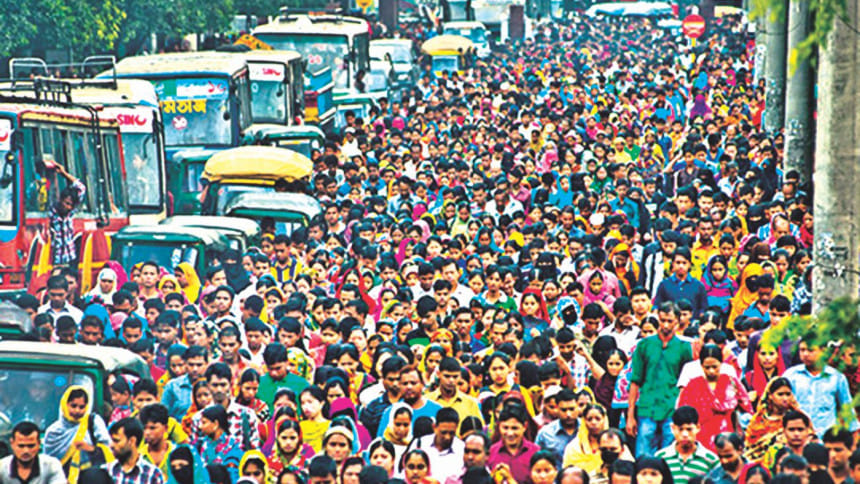Looking beyond family planning

The world observed World Population Day on July 11. The theme for this year—"Family Planning is a Human Right"—was selected in recognition of the perils that women, regardless of age, face if their right to choose when and how often to get pregnant is taken away from them. It also was an occasion to recognise that both men and women have the right to choose when and how often to embrace parenthood—if at all.
It is now known that billions of women globally still do not have access to safe and effective family planning methods, a basic human right. Freedom to choose pregnancy is also embedded in the UN's Sustainable Development Goals and is a key driver of gender equality and women's empowerment. Furthermore, family planning and freedom of choice are important enablers in reducing poverty.
As of July 1, 2018, Bangladesh is the world's eighth largest country in terms of population and our population density is one of the highest in the world. These numbers present challenges as well as opportunities. Our GDP has been growing at a decent clip over the last two decades raising the per capita income, but our economy has failed to create enough jobs to absorb new entrants.
For us, the World Population Day provides an opportunity to reaffirm that our population must be provided with other basic human needs. While rapid growth of population strains our limited resources, and family planning is an important component of population management, we must also simultaneously address related issues as we march towards sustainable growth: job growth, better education, and equal access to resources.
If we now turn to the South Asian region, it has three of the world's most heavily populated countries: India (2nd), Pakistan (6th), and Bangladesh. Population experts consider the fertility rate, i.e. the number of births per women, as an indicator of the opportunities that women have for gainful employment and their overall status in society. For example, fertility rate in Pakistan was 3.55 as of 2015 with 2.4 for India and 2.14 for Bangladesh, and these numbers appear to be correlated with the socioeconomic status of women in these countries.
Demographic studies reveal that a fall in fertility levels and slower population growth, for example, lead to an increased concentration of the population in the working age range, which can enable countries to reap a demographic bonus and jumpstart economic development. Populations in many parts of the world are still young, creating an opportunity for countries to capture a demographic dividend. In Africa, children under age 15 account for 41 percent of the population in 2015 and young persons aged 15-24 account for a further 19 percent. On the other hand, Latin America and the Caribbean and Asia, which have seen greater declines in fertility, have smaller percentages of children (26 and 24 percent, respectively) and similar percentages of youth (17 and 16 percent, respectively). In total, these three regions are home to 1.7 billion children and 1.1 billion young persons in 2015.
However, these children and young people are future workers and parents, who can help to build a brighter future for their countries. Providing them with health care, education and employment opportunities, particularly in the poorest countries and groups, will be a critical focus of UN's Sustainable Development Goals (SDGs).
Studies show that regardless of which route is chosen to implement all SDGs successfully by 2030, rapid population growth will make achieving these goals more difficult and more expensive. The reason for this is simple: the SDGs must be delivered for each individual in society. The more people there are, the more will have to be done to achieve that.
On the other hand, achieving the SDGs by 2030 would lead to a global population of only 8.2-8.7 billion by 2100 in contrast to a population of 1.2 trillion forecast without SDGs. According to a study conducted by the International Institute for Applied Systems Analysis (IIASA) and the Asian Demographic Research Institute at Shanghai University, achieving the SDGs would lead to a population growth below even the lower bound of recent UN probabilistic population projections.
The study is the first to assess how successful implementation of the SDGs would affect population growth, and concludes that achieving the SDGs would lead to the global population peaking by 2060, and declining to between 8.2 and 8.7 billion by 2100.
"The key factors are the effects of increasing female education on lowering birth rates in developing countries, and the health target that includes universal access to reproductive health services," says IIASA population researcher Samir KC, who also worked on the study. Achieving these two goals, the study showed, would lead to reduced fertility rates in much of the developing world. The researchers note that achieving the SDGs would also lead to reduced mortality, which would tend to increase population, but in the longer term, decreased mortality rates also contribute to lower birth rates. Even if the goals were only partly achieved, the study finds a potentially significant decrease in population growth.
Dr Abdullah Shibli is an economist, and Senior Research Fellow, International Sustainable Development Institute (ISDI), a think-tank in Boston, USA. His new book Economic Crosscurrents will be published later this year.





Comments